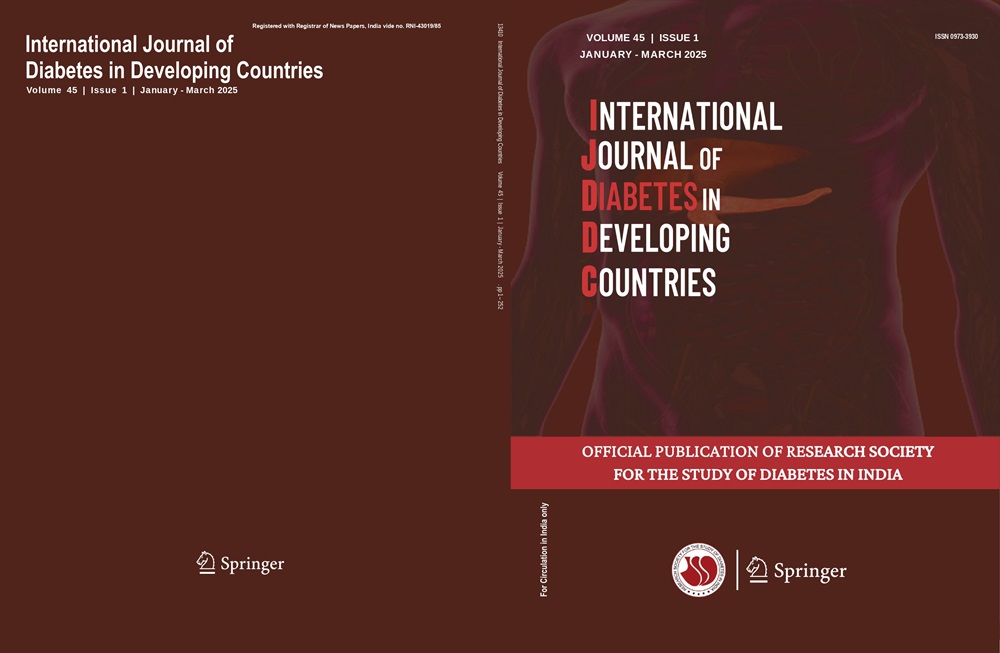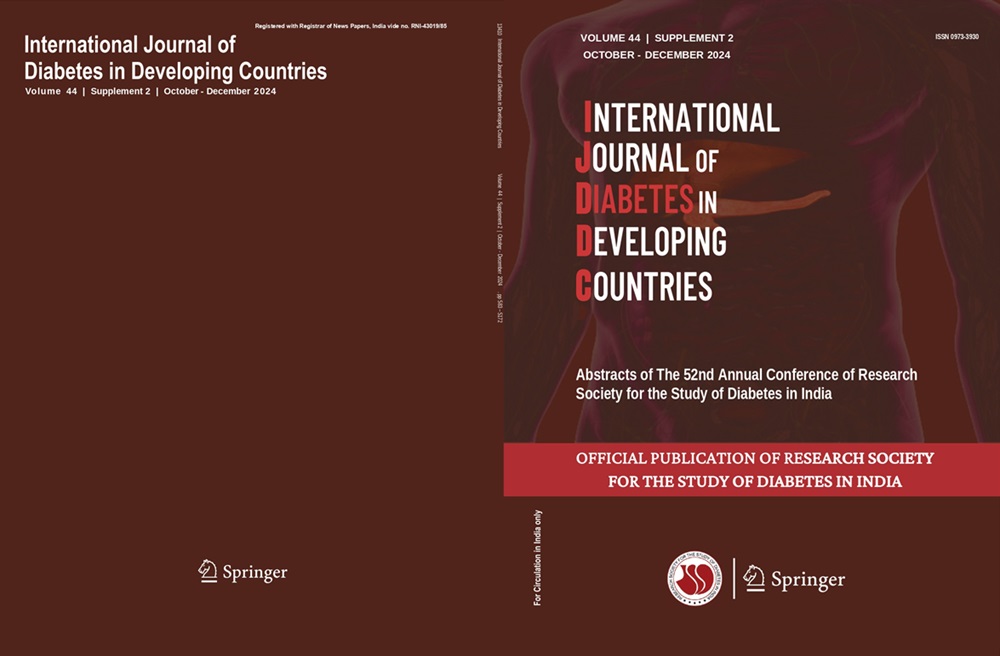Rajeev Chawla, Abhishek Garg
Diabetic nephropathy (DN) remains a critical concern in the management of diabetes, significantly impacting patient health outcomes and healthcare systems. Recent research has illuminated several facets of DN, from inflammatory biomarkers and genetic factors to the effects of nutrition and new diagnostic methods. This editorial integrates findings from recent studies to provide an updated perspective on the understanding and management of diabetic nephropathy.
Inflammatory markers and genetic influences
Recent research underscores the importance of inflammation in diabetic nephropathy. A systematic review by Chastene Christopher Flake, Imoan Shallom Aguas, and Raphael Enrique Tiongco in this issue of the International Journal of Diabetes in Developing Countries highlights elevated levels of tumor necrosis factor-alpha (TNF-α) and interferongamma (IFN-γ) in patients with DN. These inflammatory cytokines are consistently higher in DN patients compared to those with type 2 diabetes mellitus (T2DM) without renal complications and healthy controls. Notably, these markers correlate negatively with estimated glomerular filtration rate (eGFR) and positively with albumin-to-creatinine ratio (ACR), emphasizing their role in the inflammatory processes that aggravate renal damage [1].
Furthermore, a study by Brijesh K. Dabhi and Kinnari Nitin Mistry, also featured in this issue, explores the role of cytokine gene polymorphisms in DN susceptibility. Variations in genes related to inflammation and apoptosis are associated with increased risk of diabetic complications, suggesting that both genetic and inflammatory factors are crucial in the pathogenesis of DN [2].
Diagnostic challenges and innovations
Accurate glucose monitoring is vital for managing diabetic kidney disease (DKD). However, Yi Lu and colleagues have found that HbA1c-derived estimates of average glucose (AG) often fail to reflect true AG levels in patients with DKD before dialysis. Their study indicates the need for revised AG-HbA1c equations that account for diabetes type, body mass index (BMI), and chronic kidney disease (CKD) stage to improve glucose management in this patient group [3].
Additionally, novel biomarkers offer new opportunities for early diagnosis and prognosis of DN. Research by Negeem and colleagues identifies elevated levels of micro-RNA-192 (miR-192) and pentraxin-3 (PTX-3) as associate with lower eGFR in DN patients, suggesting these biomarkers could enhance diagnostic precision and disease monitoring [4].
Impact ofnutrition andphysical function
Nutrition and physical health play crucial roles in the management of DN, yet they are often overlooked. Lu Zhang and Sumei Zhang’s study compares patients with and without diabetes undergoing maintenance hemodialysis (MHD), revealing that diabetic patients exhibit poorer nutritional outcomes, reduced muscle strength, and a lower
quality of life. These findings highlight the need for targeted nutritional interventions and physical therapy to improve outcomes and quality of life for patients with diabetes undergoing MHD [5].
Pathological lesions andclinical implications
A comprehensive study by Kurtipek and colleagues examines the relationship between diabetic retinopathy and renal lesions. The study reveals that diabetic retinopathy is associated with glomerular and arteriolar lesions but not with interstitial lesions. Additionally, proteinuria and hematuria are identified as independent predictors of glomerular lesions. These insights stress the importance of tailored monitoring and treatment strategies for managing specific types of renal lesions [6].
Further, research by Chawla and colleagues demonstrates a relationship between diabetic retinopathy, microalbuminuria, and modifiable risk factors, such as HbA1c and BMI, highlighting their cohesive impact on retinopathy severity[7]. Additionally, a study by Chawla and team underscores the positive correlation between cortical renal thickness and eGFR, suggesting that cortical renal thickness might serve as a better predictor of renal function compared to bipolar renal length [8].
Conclusion
The field of diabetic nephropathy is rapidly evolving with advancements in biomarkers, genetic research, and personalized care strategies. Integrating these new insights into clinical practice is essential for improving patient outcomes. Ongoing research will continue to deepen our understanding and refine strategies for early detection, management, and prevention of diabetic nephropathy. Clinicians must stay informed about these developments to provide the most effective and comprehensive care for their patients.
References
1. Flake CC, Aguas IS, Policarpio A, et al. Serum and urinary levels of tumor necrosis factor-alpha and interferon-gamma in diabetic nephropathy patients: a systematic review. Int J Diabetes Dev Ctries. 2023. https://doi.org/10.1007/s13410-023-01280-7.
2. Dabhi BK, Mistry KN, Thakor JM, etal. Cytokine gene polymorphism with type 2 diabetes and diabetic nephropathy in population from West India. Int J Diabetes Dev Ctries. 2024. https://doi.org/10.1007/s13410-023-01301-5.
3. Du Y, Wang X, Zhang Q, et al. Assessment of equations estimating average glucose among patients with diabetic kidney disease before dialysis. Int J Diabetes Dev Ctries. 2024. https://doi.org/10.1007/s13410-023-01305-1.
4. Negeem ZR, Moneim AA, Mahmoud B, et al. Association of microRNA-192, pentraxin-3, and transforming growth factorbeta1 with estimated glomerular filtration rate in adults with diabetic nephropathy. Int J Diabetes Dev Ctries. 2023. https://doi.org/10.1007/s13410-023-01283-4.
5. Zhang L, Zhang S, Shi S, etal. Diff erences in nutrition, handgrip strength, and quality of life in patients with and without diabetes on maintenance hemodialysis in Xi’an of China. Int J Diabetes Dev Ctries. 2023. https://doi.org/10.1007/s13410-023-01282-5.
6. Kurtipek AC, Cevher ŞK, Yenigün EC, etal. Clinical refl ections of diabetic nephropathy related pathological lesions. Int J Diabetes Dev Ctries. 2023. https://doi.org/10.1007/s13410-023-01300-6.
7. Chawla S, Trehan S, Chawla A, Jaggi S, Chawla R, Kumar V, Singh D. Relationship between diabetic retinopathy, microalbuminuria, and other modifiable risk factors. Prim Care Diabetes. 2021. https://doi.org/10.1016/j.pcd.2021.01.012.
8. Chawla R, Zala S, Punyani H, Dhingra J. Correlation between cortical renal thickness and estimated glomerular filtration rate in diabetic nephropathy patients. J Diabetol. 2020;11:158–62. Publisher's Note Springer Nature remains neutral with regard to jurisdictional claims in published maps and institutional affiliations.




